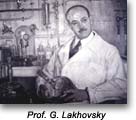
Georges Lakhovsky,
(1869-1942)
Lakhovsky's
MultiWave Oscillator |

 Georges Lakhovsky, (1869-1942) |
|
 |
|
Lakhovsky's Georges Lakhovsky, Bioelectric Pioneer Lakhovsky first experimented with plants and later confirmed his theory with animals and finally people. In 1924, he intentionally innoculated 10 potted germanium plants with a tumor-causing disease (Bacterium tumefaciens, a plant cancer). To one of the potted plants, he attached a single coil of heavy copper wire (ends not connected), holding it in place with a wooden stake stuck into the pot. The coil was about 30cm in diameter and was fashioned around the center of the plant, about 8 inches up from the soil. All of the plants had identical care and were exposed to the same lighting conditions. Over the next 60 days, the 9 innoculated germanium plants without the coil withered and died from their tumors. The single plant with the attached coil, threw off its tumors in about 30 days and continued to thrive and grow healthy. Why? According to Lakhovsky, the coil acted as an antenna and was able to capture a portion of the frequency spectrum of cosmic waves that continually bombard the earth. These captured cosmic radiations (of the correct frequency range) were able to induce or reinforce favorable oscillations in plant cells. All living cells (plants, or animals), in a healthy state, oscillate at a characteristic frequency and maintain a condition that Lakhovsky referred to as equilibrium. Pathogenic organisms (disease-causing bacteria, virus, etc.) oscillate at a different frequency and if brought into close proximity to those healthy cells, will adversely affect the frequency of the oscillations of those cells and introduce a state of disequilibrium. Lakhovsky essentially viewed it as a war taking place between the oscillatory energies of the pathogenic microbes and the host cells. If the host cells were sufficiently 'swamped' by the invading organisms' oscillations, then the host cell would succumb to the mounting disequilibrium and die off. If the resonant oscillations (the characteristic, healthy frequency) of the host cell could be stimulated or reinforced, then the host cell could overcome the disequilibrium and overpower the oscillations of the pathogenic organisms, thus defeating them. In Lakhovsky's plant experiment, the coil was able to capture cosmic radiations of a specific band of frequencies which was able to reinforce the healthy, characteristic resonant frequency of that germanium plant cell. Lakhovky later constructed a generator that could produce a wide spectrum of high frequency waves that could simulate the effects of captured cosmic radiations, but at much higher power levels. With his multi wave oscillator, Lakhovsky was able to stimulate diseased cells back into a healthy state much more quickly than depending on cosmic radiation alone. However, (and this is important), if coil antennas of the correct size are employed, cosmic radiation alone will stimulate the diseased cells back into a healthy state (in people or plants); it just takes longer. Lakhovsky believed that living cells are batteries; the nucleus holds the positive charge and the cytoplasm carries the negative. If cells were irradiated with a range of electromagnetic oscillations, they could be "recharged" and thus rejuvenated. A range of frequencies is necessary because the cell and its parts respond to different frequencies
|